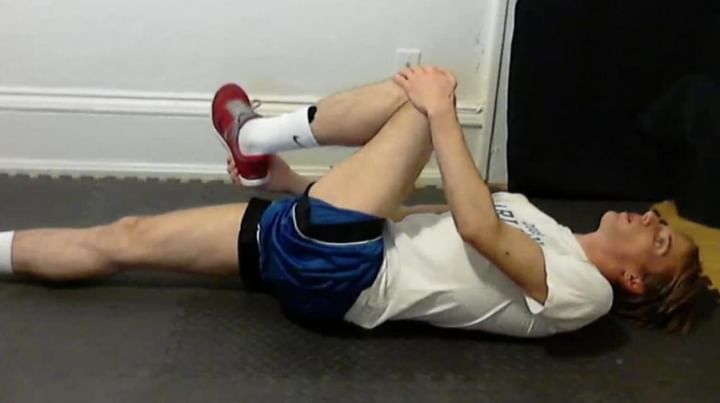What Is Piriformis Syndrome?
A common symptom of piriformis syndrome is pain along the sciatic nerve, so it is often thought that piriformis syndrome causes sciatica.
However, piriformis syndrome does not involve a radiculopathy - a disc extending beyond its usual location in the vertebral column that impinges or irritates the nerve root - so it is technically not sciatica.Instead, with piriformis syndrome, it is the piriformis muscle itself that irritates the sciatic nerve and causes sciatic pain.See What is Piriformis Syndrome?
The piriformis is a muscle located deep in the hip that runs in close proximity to the sciatic nerve. When the piriformis muscle becomes tight and/or inflamed, it can cause irritation of the sciatic nerve. This irritation leads to sciatica-like pain, tingling and numbness that run from the lower back, to the rear and sometimes down the leg and into the foot.
Supine piriformis stretches
Lie on the back with the legs flat. Pull the affected leg up toward the chest, holding the knee with the hand on the same side of the body and grasping the ankle with the other hand. Trying to lead with the ankle, pull the knee towards the opposite ankle until stretch is felt.
Do not force ankle or knee beyond stretch. Hold stretch for 30 seconds, then slowly return to starting position. Aim to complete a set of three stretches.Lie on the floor with the legs flat. Raise the affected leg and place that foot on the floor outside the opposite knee. Pull the knee of the bent leg directly across the midline of the body using the opposite hand or a towel, if needed , until stretch is felt. Do not force knee beyond stretch or to the floor. Hold stretch for 30 seconds, then slowly return to starting position. Aim to complete a set of three stretches.Lie on the floor with the affected leg crossed over the other leg at the knees and both legs bent. Gently pull the lower knee up towards the shoulder on the same side of the body until stretch is felt. Hold stretch for 30 seconds, then slowly return to starting position. Aim to complete a set of three stretches.
Typical features of any sciatica exercise program include:Core muscle strength. Many sciatica exercises serve to strengthen the abdominal and back muscles in order to provide more support for the back. Stretching exercises for sciatica target muscles that cause pain when they are tight and inflexible. When patients engage in a regular program of gentle strengthening and stretching exercises, they can recover more quickly from a flare up of sciatica and are less likely to experience future episodes of pain.Specific diagnosis. Most exercise programs will be tailored to address the underlying cause of the patient's sciatic pain, such as a lumbar herniated disc or spinal stenosis. Doing the wrong type of exercise can worsen the sciatic pain, so it is important to get an accurate diagnosis prior to starting a program of sciatica exercises.
1. Piriformis Stretch
Laying on your back, place both feet flat on the floor with knees bent. Rest your right ankle over the left knee and pull the left thigh toward your chest.Hold stretch for 30 seconds. Repeat on the other side.Remember to keep the top foot flexed to protect your knee.
2. Seated Hip Stretch
While in a seated position, cross your right leg over your straightened left leg.Hug your right knee with your left arm, making sure to keep your back straight.Hold this stretch for 30-60 seconds, and then repeat on the opposite side.
3. Pigeon Pose Start in Downward-Facing Dog pose with your feet together.
Draw your right knee forward and turn it out to the right so your right leg is bent and your left leg is extended straight behind you. Slowly lower both legs.Hold the position for five to ten breaths, then switch to the other side.
4. Self-Trigger Point Therapy
Performing self trigger-point therapy using a lacrosse or tennis ball can be very effective at delivering sciatica pain relief.All you have to do is find a painful spot in the glutes, place the ball at that location and then relax your body into the ball.Hold this position for 30-60 seconds or until you notice a significant reduction in pain. Move to the next painful spot. The total time spent on this exercise should be between 5-10 minutes.
Practicing these four exercises once or twice a day can definitely bring you much needed sciatica pain relief.



+1.svg)
